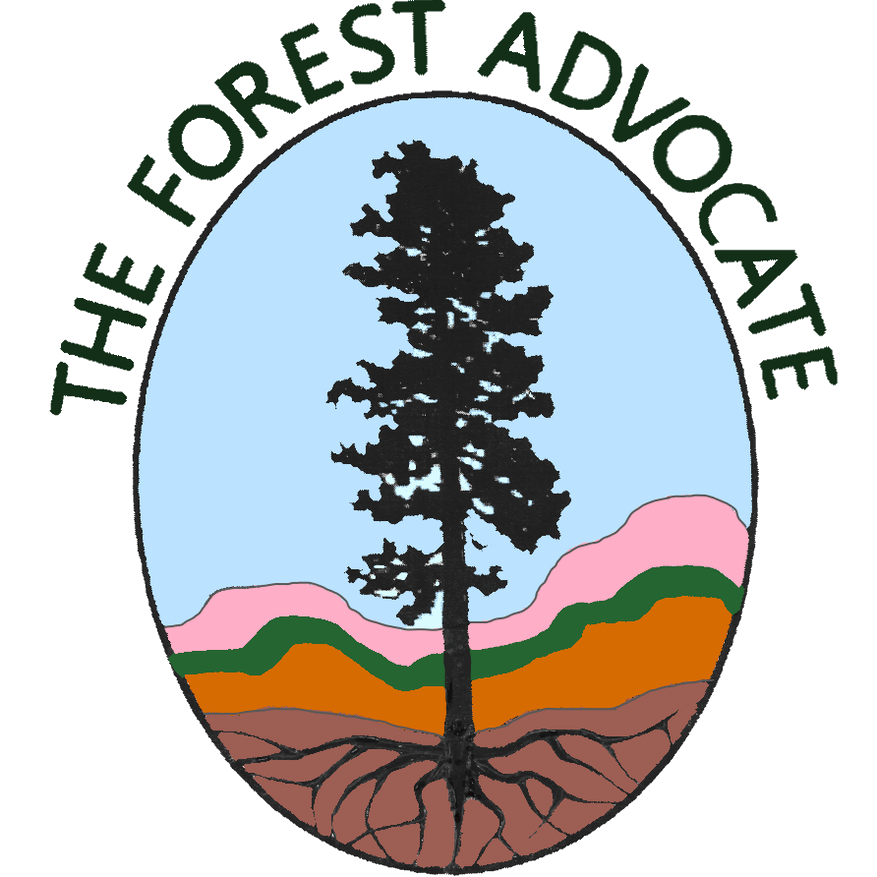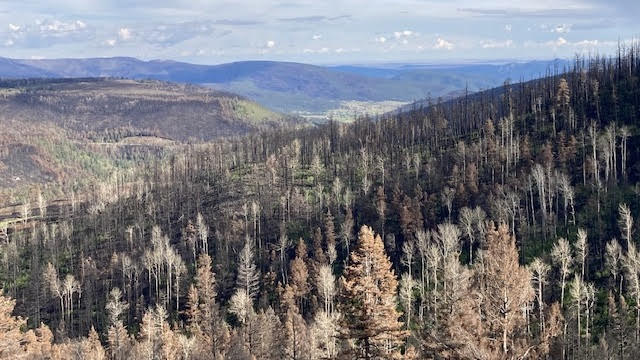|
|

|
|
|

|
|
Hermits Peak/Calf Canyon Fire burn scar — Holman Hill
|
|
While co-writing a lengthy objection to the Santa Fe Mountains Project Draft Decision, I looked at the history of escaped prescribed burns ignited by Federal agencies in New Mexico, since the year 2000. There were at least six, including the Hermits Peak and Calf Canyon Fires, resulting in a total of about 400,000 acres burned and 1,000 houses destroyed — an astonishing amount of collateral damage. An additional 17,000+ acres were burned in the Dog Head Fire, which was ignited by a spark from a masticator during a Forest Service thinning project.
|
What is particularly concerning is that the Forest Service pile burns that escaped and started the Calf Canyon Fire were very similar to pile burns that were ignited in the same project area in 2018, which also escaped and were declared a wildfire. The 2018 pile burn escape happened in late January, so the fire was able to be contained fairly quickly. We were not so fortunate in 2022. The piles smoldered under the snow until early April. Then fire escaped from the piles and was declared the Calf Canyon Fire on April 22, when high winds fanned up the flames.
|
The Forest Service prepared a review of the 2018 pile burns turned to wildfire, as well as a document called a Facilitated Learning Analysis (FLA). The purpose of an FLA is to learn lessons from an incident, in order to not repeat errors in the future. So far there has been neither a review nor an FLA released for the Calf Canyon Fire.
|
What were the lessons of the 2018 escaped pile burns that could have been remedied before 2022, in order to prevent the Calf Canyon Fire from occurring? The 2018 FLA cited lack of communication, a high turnover of burn personnel, and disagreements and shortcomings regarding burn preparation, especially regarding control lines. It seems that the lessons from the 2018 escaped pile burn fire may not have been learned sufficiently to prevent the Calf Canyon Fire.
|
Now, are we going to take the Forest Service's word for it that the lessons have been learned this time, and give them virtually carte blanche to repeatedly burn 38,000 acres of the forest just outside of Santa Fe without comprehensive analysis and public input? All this is considered in a section of the objection to the Santa Fe Mountains Project Draft Decision that we filed with our conservation partners, about the potential for escaped prescribed burns, starting on page 49. It’s a little tedious, being written in the language of objections, but the information is important.
|
The Forest Service must balance the risks of prescribed burns with the benefits, and also evaluate such parameters as when prescribed burns are carried out (is it reasonable to burn in the spring with our unpredictable winds?), how much prescribed burning can be done safely given the current agency capacity, and what is the current and projected agency capacity. Any estimates of future agency capacity for conducting prescribed burns safely must be realistic and take into account the very high turnover rate in the Santa Fe National Forest, and the understaffing here and across the national forest system. Please read this incisive op-ed by Paul Davis, a hydrologist with experience in environmental risk and decision analysis, on weighing the cost/benefit of implementing prescribed burns in the Santa Fe National Forest.
|
A cost/benefit analysis can and should be done within the context of an Environmental Impact Statement, which the Forest Service has so far refused to do for the Santa Fe Mountains Project. The objection submission period is over, but we can still write emails to our elected representatives. Ask our elected representatives – shouldn’t there be some consideration and analysis of the potential for escaped prescribed burns from the Santa Fe Mountains Project treatments, given that it just happened twice during the last year in a nearby section of the Santa Fe National Forest? Currently there is no such consideration or analysis in the Santa Fe Mountains Project Final environmental assessment. Be sure you are heard on this issue.
|
WildEarth Guardians has put out an excellent Action Alert, with a national petition requesting that an EIS be completed for the Santa Fe Mountains Project. Please sign the petition by clicking on the TAKE ACTION button below. Guardians’ requests are exactly what will benefit the project planning and analysis process, and will help to protect our forest, our communities and our health.
|
|

|

|
|
|
Tell the Forest Service to truly restore the forest
|
Stop cutting vast swaths of trees in the hope of reducing wildfires
|
|
The Forest Service has decided to aggressively cut and burn over 38,000 acres in the Santa Fe National Forest, including areas important for wildlife like the threatened Mexican spotted owl. WildEarth Guardians is challenging the decisions in the Santa Fe Mountains Landscape Resiliency Project.
|
With a false understanding of “restoration” and reducing naturally occurring wildfires, the agency is seeking authorization to cut trees and conduct controlled burns over the next 10 to 15 years without disclosing where or when it will perform these actions. This so-called condition-based management approach is a blank check in a black box that will result in the removal of large trees (up to 16 inches in diameter) across more than 24,000 acres of official Roadless Areas. This is in direct violation of rules that restrict cutting to small-diameter trees.
|
|
The Forest Service cannot replicate the effects of naturally occurring wildfire through perpetual management, broadscale tree-cutting, and frequent controlled burns. Their efforts will not restore natural ecological processes.
|
That’s why Guardians needs you to help us call on the Forest Service to:
|
- produce an environmental impact statement (EIS) that specifies where and when the agency will cut trees and conduct controlled burns
- consider alternatives, especially those that would heal scars from past agency mismanagement and truly restore the forest and create wetter, cooler areas
- rehabilitate old logging roads and illegally created roads
- restore compacted, dried-out soils and underground fungal networks
- replant eroded stream banks
- return more beavers to streams to build dams, or construct beaver dam analogs
- support fire-wise communities and help landowners make their properties safer
- reduce the size of trees they can cut to at least less than 12 inches in diameter
|
Forest restoration is not about cutting large mature trees and overly aggressive burning. It is about allowing natural processes to operate unhindered and unmanipulated.
|
Support Guardians’ effort to modify the Santa Fe Mountains Landscape Resiliency Project by sending a letter to the Forest Supervisor. Together we can ensure the agency focuses its efforts on true ecological restoration.
|
|
|
|
|
Photo credits: top photo - Emmy Koponen; bottom photo - Sam Hitt
|
|
|
|